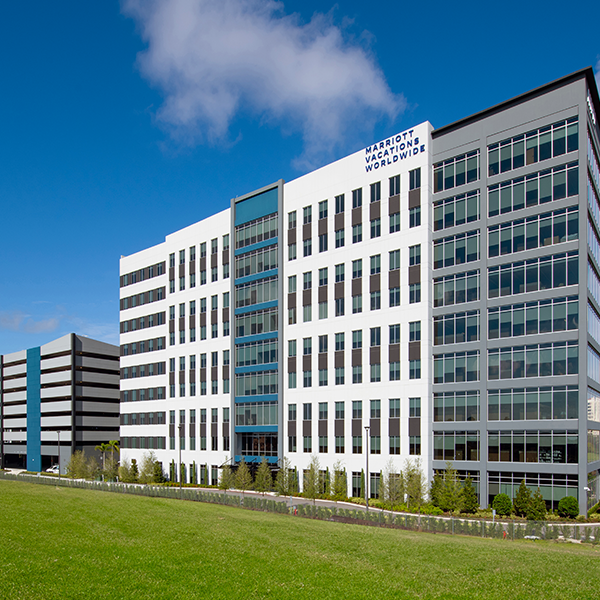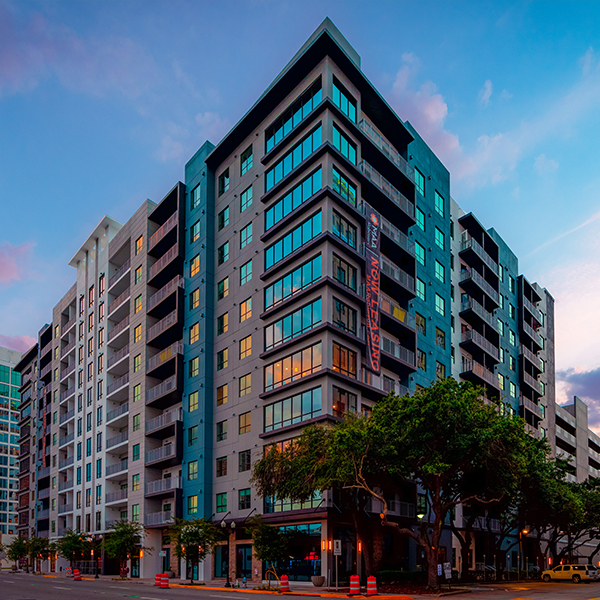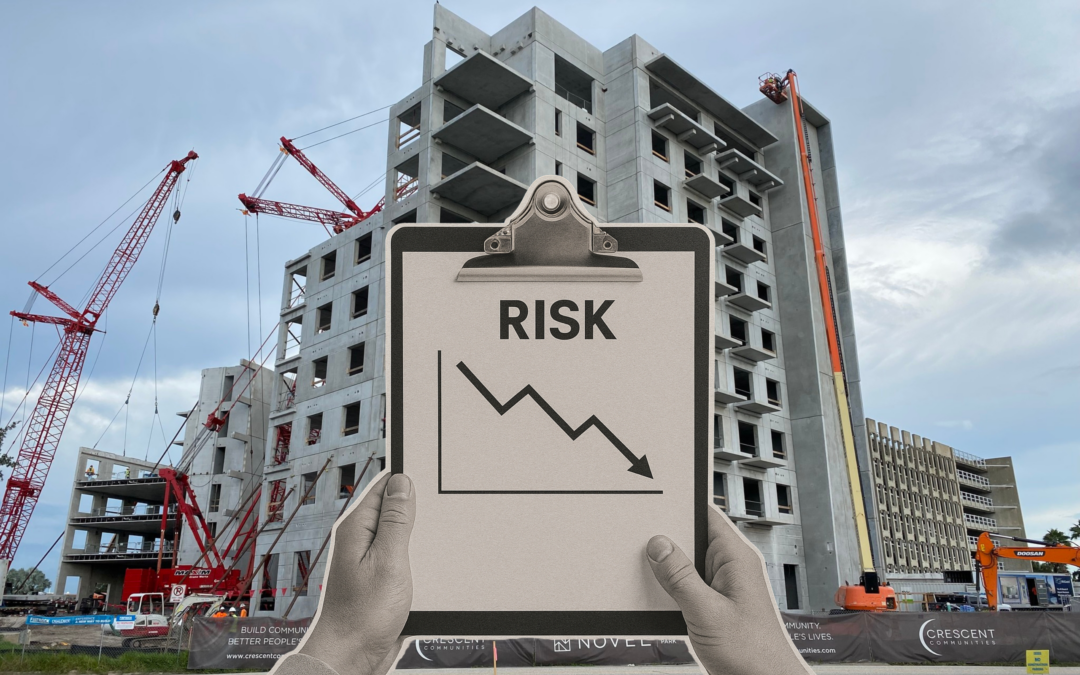Downloading this demo confirms your agreement to FINFROCK’s Terms of Use, Copyright Policy and Privacy Policy linked in the footer of this website.
Every commercial construction project carries risk. Whether it’s cost overruns, permitting delays, or schedule disruptions, the potential for problems grows with every handoff between disconnected teams. For owners and developers, managing risk isn’t just about avoiding problems, it’s about reducing uncertainty before it threatens the project’s success.
That’s where the design-build project delivery method offers a fundamental shift. Unlike design-bid-build, where risk is fragmented across architects, contractors, and consultants, design-build consolidates responsibility under a single contract. This alignment transfers much of the risk away from the owner and onto the design-builder where it can be actively managed through integrated teams, real-time coordination, and proactive planning.
Want a deeper comparison? Explore our full guide on Design-Build vs. Design-Bid-Build to see how the models differ in cost, communication, and accountability.
In this blog, we’ll show how the design-build method, especially when delivered through a vertically integrated partner, reduces risk across every phase of a commercial project. We’ll also highlight the specific processes, tools, and decisions that help owners move forward with confidence, even in today’s volatile construction market.
What Are the Most Common Risks in Commercial Construction?
Even the best-managed projects are vulnerable to a wide range of risks especially when multiple vendors, contracts, and timelines are involved. While some risks stem from external forces like market shifts or regulations, many are the result of fragmented planning, unclear roles, and limited communication between teams.
Design-build helps address these issues by reducing friction points across the project. But to understand its impact, it’s important to first identify where risk most often occurs in commercial construction:
Design & Planning Risks
- Unclear Scope or Incomplete Documents: Poorly defined project goals or drawings can lead to rework and unexpected costs.
- Permitting Delays: Missed details in early design can hold up approvals, delaying groundbreak.
- Design Conflicts or Omissions: Errors between architectural, structural, and MEP plans are common in siloed teams.
Labor & Supply Chain Challenges
- Workforce Shortages: Difficulty securing qualified trades can push schedules and increase costs.
- Volatile Material Prices: Unanticipated jumps in steel, concrete, or lumber costs create budget instability.
- Equipment Lead Times: Long-lead items like generators or elevators can delay construction without early coordination.
Contractual & Legal Disputes
- Scope Creep: Without clear responsibilities, tasks fall into gray areas, leading to delays or legal exposure.
- Ambiguous Terms: Vague contract language increases the likelihood of disagreements or litigation.
- Insurance Gaps: Overlapping or missing coverage can leave parties unprotected when issues arise.
Financial & Scheduling Instability
- Budget Overruns: Poor cost estimating or changes during construction can break the project’s pro forma.
- Payment Delays: Missed draws or slow disbursements can stall work or trigger liens.
- Financing Breakdown: Cost inflation or interest rate changes can undermine lender support.
On-Site & Environmental Issues
- Safety Incidents: Injuries or violations can stop work and increase liability.
- Unexpected Site Conditions: Soil instability or hidden obstructions often aren’t discovered until excavation.
- Weather Delays: Rain, storms, or extreme heat can delay pours or equipment delivery.
External Market and Regulatory Factors
- New Code Requirements: Mid-project rule changes can force redesign or reinspection.
- Interest Rate Fluctuations: Higher borrowing costs reduce investor returns and financing viability.
- Community Pushback: Local opposition can delay or derail project approvals.
Takeaway: Fragmented project teams amplify each of these risks. Design-build reduces exposure by consolidating responsibilities and solving problems before they impact cost or schedule.
How Design-Build Reduces Risk Across the Project Lifecycle
Design-build mitigates risk by eliminating silos, aligning stakeholders, and streamlining decisions all within a single, accountable team. This delivery method reduces uncertainty by integrating design, procurement, and construction into one continuous process. Instead of reacting to problems as they arise, design-build helps project teams anticipate and prevent them before they affect cost, schedule, or quality.
To understand how design-build reduces risk, it helps to look at where those reductions occur. Here’s a breakdown across structure, process, and outcomes:
Structural Advantages That Minimize Risk
- Single Point of Contact and Accountability
Owners don’t have to mediate between architect and builder. One contract, one team, one source of truth.
Integrated Design and Construction Teams
When design and construction collaborate from day one, plans are more buildable and better coordinated. - Unified Goals Across Stakeholders
Everyone is incentivized to deliver the best overall outcome, not just their individual piece of the project. - Clear Roles, Warranties, and Performance Standards
A well-structured design-build agreement defines expectations and responsibilities upfront, reducing ambiguity.
Processes That Actively Prevent Risk
- Early Risk Identification and Preconstruction Planning
Risks are addressed during design development, not during construction when they’re costlier to fix. - Real-Time Problem Solving and Change Management
Faster decision-making reduces delays. Problems don’t sit in inboxes, they’re solved in coordination meetings. - Contingency Planning for Budget and Schedule
Built-in allowances and flexible phasing protect the project from common disruptions. - Defined Submittal and Approval Timelines
With an integrated schedule, there’s less back-and-forth and fewer missed deadlines. - Collaborative Communication and Escalation Protocols
Everyone knows how to raise concerns, get answers, and keep moving without finger-pointing.
Project Outcomes That Reduce Owner Exposure
- Schedule Certainty and Faster Delivery
With overlapping phases and fewer delays, owners can move to revenue-generating operations sooner. - Cost Control and Avoiding Overruns
Early pricing and single-point responsibility drastically reduce change orders and budget surprises. - Higher Quality Control Standards
Quality is embedded from design through delivery, not outsourced or value-engineered away. - Reduced Time-Related and Market Risks
Faster completion minimizes the impact of interest rate hikes, inflation, or market slowdowns. - Minimized Exposure to Legal Disputes and Claims
With fewer contracts and aligned incentives, there’s less litigation and conflict.
Key Takeaway: Design-build is proactive, not reactive. It prevents problems from escalating by uniting people, processes, and priorities into a single, accountable system.
| Project Phase | Common Risks | Design-Build Advantage |
| Preconstruction | Unclear scope, inaccurate cost estimates | Unified planning and early pricing |
| Design | Coordination conflicts, change orders | Integrated design teams resolve issues early |
| Procurement | Long-lead material delays | Early identification and ordering |
| Construction | Safety issues, schedule slippage | On-site coordination with prefab delivery |
| Turnover | Punch list disputes, performance gaps | Accountability through one team and contract |
What Owners Often Get Wrong About Construction Risk
Many owners and developers assume that risk is just the cost of doing business in construction. But the reality is that much of that risk is avoidable especially with the right delivery method in place. Misunderstandings about how risk actually functions in a project often lead to decisions that unintentionally increase exposure rather than control it.
Here are some of the most common misconceptions:
- “A lower bid means lower risk.”
In traditional delivery methods, a low bid may simply reflect missing scope, poor coordination, or unrealistic assumptions, all of which lead to change orders and costly surprises later. - “Keeping design and construction separate gives me more control.”
In reality, separation often leads to finger-pointing, delays, and disputes. Design-build aligns all parties under a shared objective and provides a single source of accountability. - “I can’t know the true project cost until the design is complete.”
With a strategic design-build partner, you can get reliable cost estimates much earlier, allowing for better financial modeling, lender approvals, and go/no-go decisions. - “Change orders are just part of the process.”
Not always. Most change orders stem from miscommunication or design conflicts. In a design-build environment, coordinated teams drastically reduce the likelihood of unanticipated changes.
With design-build, risk isn’t just managed, it’s anticipated, assigned appropriately, and solved in real time.
Cost Certainty as a Strategic Risk Management Tool
In commercial construction, uncertainty around cost is one of the most significant risk factors, and one of the hardest to control in traditional delivery methods. In design-bid-build, owners often don’t receive accurate pricing until the design is complete and out to bid, leaving them vulnerable to budget overruns, value engineering compromises, or delayed financing decisions.
Design-build flips this dynamic by offering meaningful cost clarity early in the process.
How Design-Build Enables Early Cost Visibility
- Unified Teams Provide Early Input
Because designers and builders collaborate from day one, the construction team can inform material choices, structural systems, and sequencing strategies that impact budget before plans are finalized. - Preconstruction Cost Modeling
Design-build teams use target value design and preconstruction modeling to align the scope with the budget early and often. - Fewer Surprises, Fewer Change Orders
With coordinated drawings and real-time constructability reviews, errors and omissions are caught before they reach the job site.
Why Cost Certainty Reduces Broader Risk
- Faster Lender Approvals
Reliable early pricing makes it easier to lock in financing and demonstrate viability to investors and banks. - Improved Go/No-Go Decision Making
Owners can make confident decisions about whether to move forward before spending heavily on design or entitlements. - Reduced Exposure to Market Fluctuations
With procurement starting early and schedules moving faster, owners can avoid delays that would otherwise inflate material or labor costs.
At FINFROCK, we take this even further. Our vertically integrated model allows us to control costs at every stage, from structural design to precast manufacturing and construction, giving owners true cost certainty long before a shovel hits the ground.
What Risks Do Design-Build Contractors Take On?
One of the defining advantages of the design-build model is the clear transfer of risk from the owner to the design-builder. With a single entity responsible for both design and construction, the design-builder assumes a broader scope of accountability and that includes taking on risks that would otherwise fall on the owner in traditional models.
Here’s what that actually looks like in practice:
Performance Risk
Design-builders are responsible for delivering a fully functioning facility that meets the agreed performance criteria structurally, mechanically, and operationally. If the building doesn’t function as intended due to a coordination failure between design and construction, the responsibility doesn’t fall on the owner.
Design Risk
In design-bid-build, owners often carry the risk of design errors or omissions. In design-build, that risk is transferred. If there are mistakes in the drawings or coordination gaps between systems, the design-builder owns them, not the owner.
Cost and Schedule Accountability
With a guaranteed maximum price (GMP) or other cost-aligned agreement, design-builders are responsible for delivering the project within budget. Similarly, missed deadlines and schedule slippage are theirs to manage, not yours.
Licensing and Liability Exposure
Design-build contractors must carry appropriate licensing and insurance across both design and construction disciplines, protecting the owner from coverage gaps. They also assume legal liability for the completeness and safety of the work.
Site and Safety Risk
From excavation to occupancy, the design-builder is responsible for job site safety, subcontractor coordination, and construction quality. If issues arise, there’s no ambiguity about who is accountable.
Why this matters: When the right partner is chosen, this risk transfer becomes a source of confidence, not concern. Design-build lets owners focus on outcomes, while the builder manages the details, liabilities, and decisions that keep the project on track.
How FINFROCK’s Vertically Integrated Model Further Reduces Risk
In-House Design and Engineering
At FINFROCK, the architectural and structural engineering teams are fully integrated with construction from the outset. This alignment allows for coordinated decisions early in the process, reducing design errors, rework, and miscommunication between disciplines. By developing structural systems with input from those who will fabricate and build them, we eliminate costly disconnects that often lead to change orders in traditional projects.
Precast Manufacturing Under Our Control
Unlike most builders who rely on outside vendors, FINFROCK manufactures all precast components in-house. This level of control gives us consistent oversight of material quality, production schedules, and pricing. Because we aren’t waiting on external suppliers, we can avoid the long-lead delays and cost fluctuations that continue to challenge commercial construction across the industry.
Construction Executed by FINFROCK Crews
Our internal field teams manage the project on-site, building what our own teams have designed and produced. This closed-loop execution model ensures that accountability is never diluted and issues are addressed collaboratively in real time without friction between trades, consultants, or vendors. It also allows us to maintain higher quality standards and move more efficiently across phases.
Integrated Parking Structure and Vertical Building Systems
FINFROCK’s unique integration of parking and vertical building elements allows us to design and deliver a complete structure as a single system. This reduces coordination risks between trades and shortens total project time, while improving functionality and layout. Fewer consultants and subcontractors mean fewer opportunities for misalignment, a major advantage in complex, mixed-use developments.
Early Cost Certainty and Accelerated Schedules
Because we manage every phase internally, we’re able to provide accurate cost projections far earlier than most design-build teams. This gives owners and developers the insight they need to make informed investment decisions and secure financing early in the process. With our ability to begin precast manufacturing ahead of permit approval or sitework, we consistently deliver on tighter timelines, and with significantly less risk.
Real Examples of Design-Build Risk Reduction
The benefits of design-build aren’t just theoretical—they show up in measurable results. At FINFROCK, our vertically integrated model has helped clients overcome site constraints, meet complex stakeholder requirements, and maintain cost and schedule certainty even under pressure. Below are two projects where our delivery method helped reduce risk across every phase.
City Center at O-Town West: Schedule Certainty at Massive Scale

For one of the Orlando region’s most ambitious mixed-use developments, Unicorp needed a builder who could deliver a major Class A office headquarters and 8-story parking structure—on time and without compromising design. With over 350,000 square feet of office space and 2,019 parking stalls, City Center demanded seamless coordination and early cost certainty.
By selecting FINFROCK as architect, engineer, precast manufacturer, and general contractor, Unicorp minimized risk from the outset. Our ability to control design, manufacturing, and construction under one contract allowed for faster delivery and reduced exposure to delays. As a result, the Marriott Vacations Worldwide headquarters opened on schedule, fully supported by retail, restaurant, hotel, and structured parking components—all delivered through an integrated model that eliminated the need for separate contracts or costly redesigns.
MAA Robinson: Complex Site, Multi-Stakeholder Success

MAA Robinson brought together high-rise luxury living, restaurant space, and a large parking requirement on a tight urban site in downtown Orlando. In addition to delivering 369 apartment units and 3,898 square feet of retail, the development had to accommodate 200 dedicated parking stalls for a neighboring church group that previously owned the land.
FINFROCK’s integrated team—covering design, structural engineering, precast production, and construction—helped MAA navigate multiple layers of complexity without adding risk. Our in-house cost estimators aligned the garage design with budget goals, while modular precast components allowed work to proceed efficiently during COVID-related disruptions. Despite the site and stakeholder challenges, the project was completed on time with no surprises—demonstrating how design-build reduces risk, even in unpredictable environments.
Frequently Asked Questions
What types of risk does design-build reduce?
Design-build reduces many of the most common project risks, including cost overruns, schedule delays, change orders, coordination failures, and legal disputes. It also minimizes external risks like permitting issues or supply chain delays by enabling earlier planning and faster execution.
Does design-build eliminate change orders?
While not all change orders can be eliminated, design-build significantly reduces them. Most change orders in traditional delivery methods result from design conflicts or scope gaps, issues that are resolved early when design and construction teams are fully integrated.
How is cost risk managed in design-build?
Design-build teams work collaboratively during the preconstruction phase to align scope, design, and budget. This allows for earlier pricing certainty, fewer cost surprises, and better financial planning. Many design-build contracts also include guaranteed maximum prices (GMPs), further reducing owner risk.
Who holds the most risk in a design-build contract?
The design-builder assumes most of the project risk, including design accuracy, construction performance, and schedule adherence. This consolidation of responsibility simplifies communication and accountability for the owner.
What happens if something goes wrong on a design-build project?
Because all teams are under one contract, issues are resolved internally rather than through blame-shifting between separate firms. Most design-builders have structured escalation protocols, dedicated project managers, and defined dispute resolution processes to handle problems efficiently.
Choose FINFROCK to Minimize Construction Risk
Commercial construction will always carry some level of risk, but with the right delivery model and the right partner, that risk can be controlled, minimized, and managed with confidence. Design-build shifts the burden of coordination, performance, and delivery from the owner to a single accountable team. And FINFROCK takes it one step further.
As a vertically integrated design-builder, FINFROCK unites architecture, structural engineering, manufacturing, and construction under one contract and one roof. That means fewer unknowns, fewer delays, and far less exposure to the typical pitfalls of fragmented project delivery. From early cost certainty to schedule assurance and real-time problem-solving, we help owners move forward with greater clarity and less risk every step of the way.

